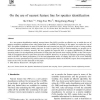Free Online Productivity Tools
i2Speak
i2Symbol
i2OCR
iTex2Img
iWeb2Print
iWeb2Shot
i2Type
iPdf2Split
iPdf2Merge
i2Bopomofo
i2Arabic
i2Style
i2Image
i2PDF
iLatex2Rtf
Sci2ools
PRL
2002
2002
On the use of nearest feature line for speaker identification
As a new pattern classification method, nearest feature line (NFL) provides an effective way to tackle the sort of pattern recognition problems where only limited data are available for training. In this paper, we explore the use of NFL for speaker identification in terms of limited data and examine how the NFL performs in such a vexing problem of various mismatches between training and test. In order to speed up NFL in decision-making, we propose an alternative method for similarity measure. We have applied the improved NFL to speaker identification of different operating modes. Its text-dependent performance is better than the dynamic time warping (DTW) on the Ti46 corpus, while its computational load is much lower than that of DTW. Moreover, we propose an utterance partitioning strategy used in the NFL for better performance. For the text-independent mode, we employ the NFL to be a new similarity measure in vector quantization (VQ), which causes the VQ to perform better on the KING...
| Added | 23 Dec 2010 |
| Updated | 23 Dec 2010 |
| Type | Journal |
| Year | 2002 |
| Where | PRL |
| Authors | Ke Chen 0001, Ting-Yao Wu, HongJiang Zhang |
Comments (0)

